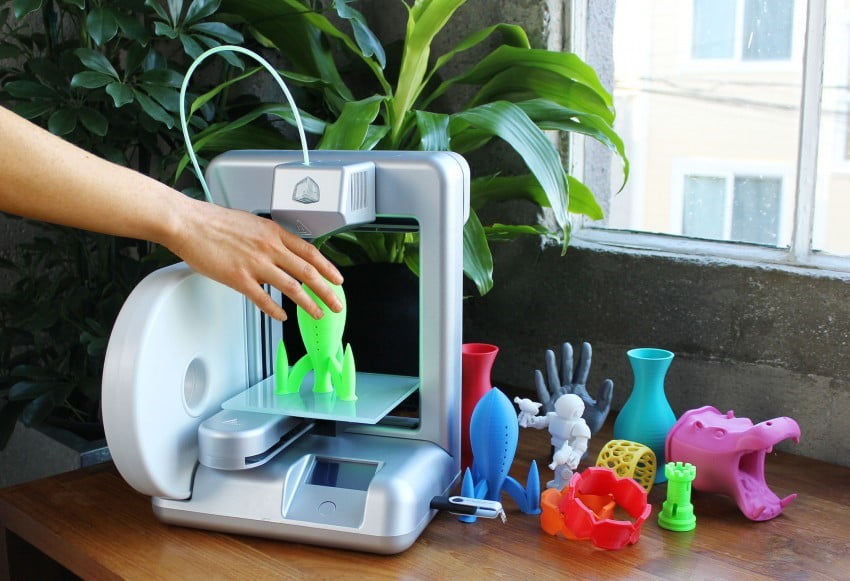All printing technologies require a substance to print with. In 2D printing, the most common type of material used for printing is liquid ink. An exception, however, is 2D laser printing. 2D laser printers use a combination of laser beams and electrical currents to print graphics or text onto paper.
However, since 3D printing produces three-dimensional objects, it requires different types of materials.
Materials that can be 3D printed are numerous but vary according to application. 3D printing materials typically take the form of a filament, like the type of string you see on a weed whacker or trimmer, though some materials are in powder form or liquid resin.
If you are new to 3D printing, this article will give you an overview of the five most common types of materials and why they are the most popular choices in 3D printing today.
1. Plastics
Perhaps the most common material used in 3D printing is plastic. Plastics are what really ignited the 3D printing revolution. But the type of plastic used in 3D printing is not your everyday plastic material. In 3D printing, plastic filaments are known as polymers or thermoplastics.
The most common thermoplastic filaments are:
- Acrylonitrile butadiene styrene (ABS)
- Polylactide or polylactic acid (PLA)
- Polycarbonate (PC)
- Thermoplastic elastomers (TPE)
- Nylon
Thermoplastics can be used for a variety of applications. This can include concept models, rapid prototyping, consumer products, and various surgical implants.
2. Metal
There are two ways metal can be used in 3D printing, powder or wire feedstock. The process being used and the required application will determine which material is used. The more common process of the two is wire feedstock.
The most common materials available both in powder and wire form include:
- Titanium
- Stainless steel
- Tungsten
- Aluminum
- Precious metals (gold, silver, platinum, palladium)
The most common way metal is 3D printed is through direct metal laser sintering (DMLS). This method allows for accurate metal manufacturing not available through other manufacturing methods.
DMLS products are stronger and denser and can be formed into various complex geometries. Applications of metal 3D printing, particularly DMLS, include production parts (ducts, housings, enclosures, etc.), functional prototyping, and thermal control systems.
An early proponent of DMLS printing is the aviation industry.
3. Resin
Resin-based 3D printing is one of the few instances of 3D printing where a liquid material is used to create a three-dimensional object. The liquid resin is cured with the use of a UV laser through a process called “photopolymerization.”
Liquid resin is available through a resin tank or a resin cartridge.
There are six standard resin materials:
- Standard grey resin
- Dental resin
- Castable resin
- Tough resin
- Durable resin
- Flexible resin
Different material properties can be used for a wide range of applications. Dental resin, for example, is capable of producing dental implants. Standard resin is ideal for prototyping applications such as concept modeling or art models.
4. Sandstone
Sandstone is a composite 3D printing material combining a binding agent such as PLA or nylon to a gypsum-based powder. The fused deposition modeling (FDM) or fused filament fabrication (FFF) technique is typically applied to this composite material to create the finished product.
The FDM/FFF technique deposits materials one single layer at a time, fusing each successive layer until the object is complete. FDM/FFF is one of the most well-known 3D printing techniques available today.
Sandstone is generally used for niche products that require multi-color printing and a stone-like finish. This usually applies to architectural models, figurines and showcase models, or interesting design pieces. Since the final product is a hard, brittle material, sandstone is not ideal for functional parts. Furthermore, its brittle nature also means that the final product must be handled with care.
Unlike other materials, sandstone is also not water-resistant. Any exposure to water can result in fading.
5. Biomaterials
A growing segment in 3D printing is bioprinting. This additive manufacturing uses biomaterials to produce tissue-like structures and artificial organs.
Typical biomaterials used in 3D bioprinting include:
- Gelatin
- Collagen
- Alginate
- Nano-fibrillated cellulose (NFC)
- Methacrylate hyaluronic acid (MeHA)
Currently, 3D bioprinting is in the proof of concept stage. The latest breakthrough in this segment of 3D printing was the production of a rodent-sized printed heart complete with muscles and blood vessels.
While this shows promise, the technology is still many years away from printing viable artificial human organs.
Final considerations
Choosing the right material for a design or project depends on several factors. For instance, if your final product is concept modeling for a tradeshow, sandstone or thermoplastic will be ideal. Meanwhile, a project that requires a functional prototype may benefit from using metal.
The best way to know which 3D printing material is right for your application is to work with a 3D printing services agency that can guide you through the manufacture of your design the right way.
AUTHOR BIO
Pir Arkam is the Founder of Proto21 3D Printing LLC in the UAE. The company is dedicated to accelerating 3D printing and additive manufacturing adoption by providing rapid prototyping services with a free consultation and delivering 3D printing training workshops. Proto21 has a solution for every phase of the product development cycle in all of the major industries.




Leave a Reply